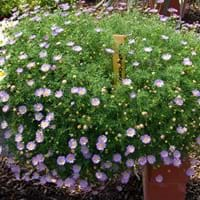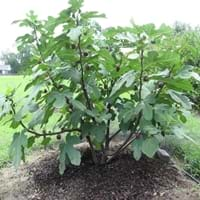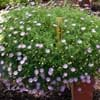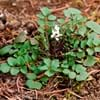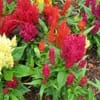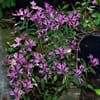Life Span
Annual
Perennial
Type
Tender Perennial
Fruit
Origin
Hybrid origin, Australia, New Zealand
Mediterranean, Southeastern Asia, Western Asia
Types
Not Available
Not Available
Habitat
Dry areas, Islands, Semi arid regions, Tropical regions
Dry areas
USDA Hardiness Zone
10-12
6-10
Sunset Zone
H1, 14, 15, 16, 17, 18, 19, 20, 21, 22, 23, 24
H1, H2, 4, 5, 6, 7, 8, 9, 12, 13, 14, 15, 16, 17, 18, 19, 20, 21, 22, 23, 24
Habit
Cushion/Mound-forming
Oval or Rounded
Flower Color Modifier
Bicolor
Bicolor
Fruit Color
Not Available
Green, Purple, Dark Green, Bronze, Brown
Leaf Color in Spring
Green
Green, Dark Green
Leaf Color in Summer
Green
Green, Dark Green
Leaf Color in Fall
Green
Green, Dark Green
Leaf Color in Winter
Light Green
Light Green
Leaf Shape
Club - shaped
Lobed
Plant Season
Spring, Summer, Fall, Winter
Spring, Summer, Fall
Sunlight
Full Sun, Partial Sun
Full Sun, Partial Sun, Partial shade
Type of Soil
Loam, Sand
Clay, Loam, Sand
The pH of Soil
Acidic
Acidic, Neutral
Soil Drainage
Well drained
Well drained
Bloom Time
Indeterminate
Spring, Early Summer
Tolerances
Drought
Drought
Where to Plant?
Container, Ground, Pot
Container, Ground, Pot
How to Plant?
Seedlings
Seedlings, Stem Planting
Plant Maintenance
Medium
Medium
Watering Requirements
Average Water Needs
Requires regular watering
In Summer
Lots of watering
Lots of watering
In Spring
Moderate
Moderate
In Winter
Average Water
Average Water
Soil pH
Acidic
Acidic, Neutral
Soil Type
Loam, Sand
Clay, Loam, Sand
Soil Drainage Capacity
Well drained
Well drained
Sun Exposure
Full Sun, Partial Sun
Full Sun, Partial Sun, Partial shade
Pruning
Remove damaged leaves, Remove dead branches, Remove dead leaves
Remove damaged leaves, Remove dead branches, Remove dead leaves
Fertilizers
All-Purpose Liquid Fertilizer
All-Purpose Liquid Fertilizer
Pests and Diseases
Slugs, Snails
Red blotch
Plant Tolerance
Drought
Drought
Flowers
Showy
Insignificant
Flower Petal Number
Single
Not Available
Foliage Texture
Fine
Coarse
Foliage Sheen
Glossy
Matte
Attracts
Not Available
Birds
Allergy
Not Available
Poisonous when unripe
Aesthetic Uses
Beautification, Hanging Basket, Showy Purposes
Not Available
Beauty Benefits
Not Available
Not Available
Environmental Uses
Air purification
Air purification
Medicinal Uses
No Medicinal Use
Cancer, Demulcent, Digestive, Emollient, Galactogogue
Part of Plant Used
Flowers, Leaves
Fruits
Other Uses
Used as Ornamental plant
Garland
Used As Indoor Plant
No
No
Used As Outdoor Plant
Yes
Yes
Garden Design
Bedding Plant, Container, Edging, Hanging Basket, Mixed Border, Rock Garden / Wall
Container, Edible, Feature Plant, Fruit / Fruit Tree, Houseplant, Topiary / Bonsai / Espalier, Tropical
Botanical Name
BRACHYSCOME iberidifolia
FICUS carica 'Celeste'
Common Name
Brachycome iberidifolia, Swan River Daisy
Celeste Fig, Fig
In Hindi
swan river daisy
अंजीर
In German
Swan River Gänseblümchen
Echte Feige
In French
Swan River daisy
Ficus carica
In Spanish
Río Swan margarita
Ficus carica
In Greek
Swan River μαργαρίτα
Celeste Fig
In Portuguese
daisy Swan River
Figueira-comum
In Polish
Swan River stokrotka
Figowiec pospolity
In Latin
Swan flumen primula
Ficus carica
Phylum
Tracheophyta
Magnoliophyta
Class
Magnoliopsida
Magnoliopsida
Order
Asterales
Urticales
Family
Asteraceae
Moraceae
Clade
Angiosperms, Asterids, Eudicots
Angiosperms, Eudicots, Rosids
Subfamily
Asteroideae
Not Available
Number of Species
Not Available
Season and Care of Swan River Daisy and Celeste Fig
Season and care of Swan River Daisy and Celeste Fig is important to know. While considering everything about Swan River Daisy and Celeste Fig Care, growing season is an essential factor. Swan River Daisy season is Spring, Summer, Fall and Winter and Celeste Fig season is Spring, Summer, Fall and Winter. The type of soil for Swan River Daisy is Loam, Sand and for Celeste Fig is Clay, Loam, Sand while the PH of soil for Swan River Daisy is Acidic and for Celeste Fig is Acidic, Neutral.
Swan River Daisy and Celeste Fig Physical Information
Swan River Daisy and Celeste Fig physical information is very important for comparison. Swan River Daisy height is 20.30 cm and width 30.50 cm whereas Celeste Fig height is 300.00 cm and width 300.00 cm. The color specification of Swan River Daisy and Celeste Fig are as follows:
Swan River Daisy flower color: White
Swan River Daisy leaf color: Green
Celeste Fig flower color: Green
- Celeste Fig leaf color: Green and Dark Green
Care of Swan River Daisy and Celeste Fig
Care of Swan River Daisy and Celeste Fig include pruning, fertilizers, watering etc. Swan River Daisy pruning is done Remove damaged leaves, Remove dead branches and Remove dead leaves and Celeste Fig pruning is done Remove damaged leaves, Remove dead branches and Remove dead leaves. In summer Swan River Daisy needs Lots of watering and in winter, it needs Average Water. Whereas, in summer Celeste Fig needs Lots of watering and in winter, it needs Average Water.
